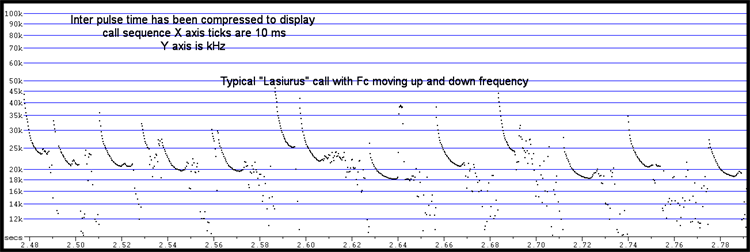Vespertilionidae
Guide for Acoustic Identification of Florida bats
Lascin or Laci
See glossary for explanation of codes
Lasiurus cinereus (Palisot de Beauvois, 1796)
Taxonomy follows Simmons and Cirranello (2021)
To view call graphics click on the camera icon on the right. You can then move through all images by using the left or right arrow keys. A left mouse click returns to the fact sheet.
Typical North American Vespertilionid pulses with FM reversed J broadband pulses of short duration. However, distinctive for the genus Lasiurus the Fmin shifts up and down. Note that commute calls are longer duration, have a lower frequency and are narrow band.
| Parameters | N | Min | Max | Mean | St.Dev | 10% | 25% | 75% | 90% |
| Dur | 556 | 0.36 | 20.79 | 10.02 | 4.01 | 3.79 | 8.16 | 12.62 | 14.70 |
| TBC | 507 | 1.5 | 6947.1 | 703.0 | 924.1 | 148.0 | 256.6 | 752.7 | 1634.3 |
| Fmin | 556 | 18.02 | 23.92 | 20.46 | 1.22 | 18.91 | 19.54 | 21.30 | 22.12 |
| Fmax | 556 | 20.46 | 39.80 | 26.76 | 4.17 | 22.27 | 23.49 | 28.99 | 33.06 |
| BW | 556 | 0.13 | 18.00 | 6.29 | 3.82 | 1.91 | 3.51 | 8.31 | 12.23 |
| Fmean | 556 | 20.02 | 26.09 | 22.14 | 1.35 | 20.47 | 21.05 | 23.04 | 24.10 |
| Fk | 556 | 18.82 | 24.92 | 22.31 | 1.22 | 20.81 | 21.33 | 23.15 | 23.99 |
| FcH1 | 556 | 9.05 | 12.00 | 10.50 | 0.59 | 9.76 | 10.05 | 10.93 | 11.31 |
| Fc | 556 | 18.10 | 23.99 | 21.01 | 1.17 | 19.53 | 20.10 | 21.86 | 22.62 |
| FcH3 | 556 | 27.15 | 35.99 | 31.51 | 1.76 | 29.29 | 30.14 | 32.79 | 33.92 |
| Sc | 556 | 7.16 | 34.88 | 20.59 | 6.84 | 12.00 | 15.13 | 25.68 | 30.86 |
| Pmc | 556 | 0.30 | 86.50 | 27.34 | 17.90 | 5.25 | 13.60 | 37.28 | 54.60 |
Reported by Szewczak (2018)
| Lascin | Fc | Fmax | Fmin | FmaxE | dur | uppr slp | lwr slp | slp @ Fc | total slp |
| Mean | 21.1 | 26.0 | 19.7 | 20.8 | 11.0 | 2.2 | 0.4 | 0.0 | 0.7 |
| Max | 22.0 | 31.0 | 22.0 | 23.0 | 15.0 | 4.1 | 0.8 | 0.2 | 1.4 |
| Min | 18.0 | 21.0 | 18.0 | 18.0 | 7.0 | 0.3 | 0.1 | -0.1 | 0.1 |
Chris Corben
|
|
Least concern; Ver.3.1. Population trend - unknown; evaluated 2016. (I.U.C.N. 2017.)
Baird et al. (2015) appeared to make a strong case of separating the genus Lasiurus into 3 genera; proposing that the genus name Lasiurus be restricted to red bats, Dasypterus be used as the genus name for yellow bats, and hoary bats plus L. egregius (which appears more closely related to hoary bats than to red bats) be reassigned to the genus Aeorestes.
However, Ziegler et al. (2016) stated "That there was insufficient justification for changing the well-established zoological nomenclature for these bats, and any potential value of applying different generic names to the three clades is far outweighed by the confusion that these name changes will cause.” Therefore, the classical nomenclature for the genus is maintained in these Fact Sheets and carried over to the Interactive ID keys to the vocal signatures of the Lasiurines.
Baird, A. B., et al. 2015. Molecular systematic revision of tree bats (Lasiurini): doubling the native mammals of the Hawaiian Islands. Journal of Mammalogy 96:1255-1274
Marks, C. S., and G. E. Marks. 2006. Bats of Florida. Pp. 176. University of Florida Press, Gainesville.
Simmons, N. B., and A. L. Cirranello. 2020. Bat Species of the World: A taxonomic and geographic database. http://batnames.org
Szewczak, J. M. 2018. Echolocation Call Characteristics of Eastern U.S. Bats. Echolocation call characteristics of Eastern U.S. Bats. Unpublished report.
The IUCN 2017. Red List of Threatened Species. Version 2017-1.www.iucnredlist.org;. Downloaded on August 6, 2017.
Ziegler, A. C., F. G. Howarth, and N. B. Simmons. 2016. A second endemic land mammal for the Hawaiian Islands: a new genus and species of fossil bat (Chiroptera: Vespertilionidae). American Museum Novitates. 3854: 1-52.









